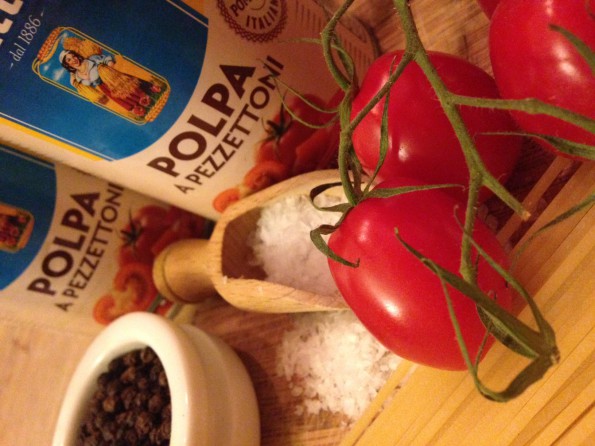Bolognese sauce or ragù alla Bolognese has a certain mysticism attached to it. It has a near hallowed tradition, not unlike Christmas dinner, in most family homes about how it is prepared and what it contains. Indeed, I’ve even had arguments with friends about the addition of certain ingredients and whether their inclusion or absence constitutes the “real” Bolognese. So what is the real Bolognese? In actual fact, the word ragù basically means a meat based sauce and in reality the word is much like an Irish stew in its vagueness. Show me an indisputable and authoritative recipe for Irish stew and I think you get my point. Spaghetti Bolognese, Bolognese sauce, or ragù alla Bolognese is exactly the same. So popular and yet divisive the dish that when I came to look at it I decided to break it down to two parts; the techniques you can use for your Bolognese, and secondly my recipe for it.

Ingredients
As I mentioned in my very first post, I’ve always tried to make it my culinary mission/mantra to make the most out of the ingredients at hand. I’ve tried to accomplish this through the idea of using the best possible ingredients, along with certain processes and techniques that I have picked up down through the years. I try to apply this to everything that I do in the kitchen, from trying something new but particularly to familiar favourites that everybody knows; from Spaghetti Bolognese to chilli con carne. In essence, what I’m trying to do is this: How can you elevate your minced beef and your shop bought jar of sauce from your quick midweek meal to something that delivers on increased flavour? For me, the answer is pretty simple… time. Unfortunately I appreciate there are many that don’t have, or indeed chose not to spend, that bit of extra time on their meals. However, even if you are short on time there are a number of things that you can do. So lets take the humble aforementioned Bolognese ragù and I’m going to list what I believe will take it to another level. These are my golden rules so to speak and these techniques and ideas, particularly 4 to 7, can be applied to all recipes. Pick and choose as you wish but there is just one essential that I ask and it’s so important I’m listing it at number one.
- Ditch the jar: Quick and easy it might be but if you make any culinary resolution I implore you to try to start cooking, even just one meal a week, from scratch. I promise you won’t ever go back.
- Brown off your meat: Colour on meat means flavour. I cannot emphasise this enough. The number one priority of any meal should be to pack as much flavour as possible into every mouthful. You might need to do this in batches depending on how much you’re cooking. Overloading too much meat into your frying pan brings down the heat dramatically, leading to the beef starting to sweat and it begins to boil in it’s own juices rather than frying. You should always hear the soft symphony of sizzling. You can and should use all your senses when cooking. One technique that I have stumbled upon recently was when I read that Tom Kerridge cooks off his minced beef in the oven. It gets the meat nicely browned and crispy and also frees up time for you to chop, dice, and prepare the other ingredients for the rest of the dish while the oven does its magic on the beef. I’ll be using this technique in this recipe
- Don’t waste those “bits” in the pan: Remember flavour? Those brown “bits” left in the pan after frying off your minced beef are just that, and we don’t want to waste them. Save them by doing that chefy term you may have heard of; deglazing. This is essentially adding a liquid to a hot pan to “clean” it. In this case that liquid is red wine and even half a glass will do. While I’m on it please never use insipid, old, vinegary or really cheap wine when cooking. I’m not saying for a second to raid the cellar for that 1967 Beaujolais but just don’t add wine to food that you wouldn’t drink yourself. Just think, you wouldn’t put really cheap, nasty, out of date meat into your ragù. The same philosophy should apply to all your ingredients.
- Season: Salt gets a pretty bad rep and of course in excess it obviously isn’t good for you. However, we do need salt in our system and so if you’re not using the jar that’s packed with sugar and salt, you can have some liberty. Salt brings out the flavour of food; there’s that word again, flavour. I use Maldon sea salt flakes because I think it has a superior quality but whatever you use be sure to. Seasoning is vital to any dish.
- Taste: Tasting your food as it’s cooking not only gives you an idea of how flavours change, enhance, or mellow as your meal cooks but also gives you an opportunity to add something that you feel will improve the taste. Everyone has a different sense of what they like, so if you feel it needs some more salt or pepper you will know this only by tasting. Be warned however, always remember you can add more of an ingredient but it’s nearly impossible to take it away once it’s added so add a little, taste, revaluate.
- Balancing taste and flavours: Our taste buds pick up on certain things, specifically; sweet, sour, salty, bitter, and umami (which basically means savoury). Not every meal has to have all these elements together of course. However, let’s take one of the main components of a Bolognese, tomatoes. Tomatoes can tend to be sweet so to offset this sweetness a little splash of red wine vinegar can help here. Paradoxically tinned tomatoes can at times be acidic so some sweetness can counterbalance. Also, believe it or not, a couple of tablespoons of tomato ketchup can add that sweet vinegar sharpness to your Bolognese. Adding in some milk also really helps to “round” out the overall flavour.
- Time: If you can, give it the time to develop that it deserves. You don’t have to cook it for 12 hours don’t worry! However do try to give it about 2 ½ hours at a low simmer if you can. The world will not implode if you cook it for less.

